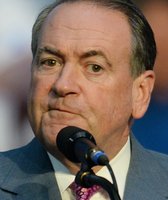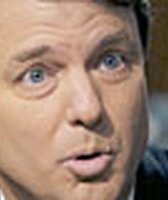Stand up for the facts!
Our only agenda is to publish the truth so you can be an informed participant in democracy.
We need your help.
I would like to contribute
SUMMARY: To illustrate his concerns about a fence between the United States and Mexico, Bill Richardson cites problems with the Great Wall of China and the Berlin Wall. But the history of those famous fences is not so clear.
Two years ago, about 2,500 vehicles crossed into Yuma, Ariz., each day carrying undocumented immigrants from Mexico. Today, the number of "drive-throughs" is about 500.
Farther south in San Luis, Ariz., Border Patrol agents detain only a handful of immigrants, compared with the hundreds who used to flood across the border there.
"What we used to see on a nightly basis is nonexistent now," said Lloyd Easterling, a supervisor for the Department of Homeland Security.
In Yuma, he said, the difference is a "vehicle fence" of closely spaced concrete bollards sticking out of the sand for miles. In San Luis, it's a 12-foot-high double fence with surveillance cameras and stadium lighting.
Both are part of a 700-mile barrier under way along stretches of the 2,000-mile U.S. border with Mexico, the centerpiece of the U.S. government's effort to gain "operational control" of its borders. Approved a year ago this week by a Republican-controlled Congress eager to score pre-election points on the immigration issue, the border fence is in a league with history's epic walls.
That's not a very flattering comparison to some, including Democratic presidential candidate Bill Richardson, the governor of New Mexico, where part of the wall already is under construction.
"You have a 12-foot fence. You know what'll happen? Thirteen foot ladders," Richardson said earlier this month in a CNN interview. "Fences have not worked. The Great Wall of China, the Berlin Wall. That's not good among peoples, especially friends like the United States and Mexico."
The comparison is apt, but Richardson's conclusion is open for discussion.
Of the two historic walls Richardson invokes, the U.S. border fence most resembles the Great Wall of China, which actually is several walls of varying quality built over many dynasties – not the stalwart, continuous barrier that we imagine from postcard pictures.
The wall has a "less than glorious past," writes Julia Lovell in her 2006 book, The Great Wall: China against the World, 1000 BC-AD 2000 .
"The forces that walls were designed to keep out – highly mobile nomadic tribes – tended to gallop along frontier walls until they found weaknesses in them, or, less effortfully, simply bribe wavering Chinese generals to open key wall forts," Lovell said in an e-mail interview from her home in Beijing. The wall worked best "when used in conjunction with a flexible range of other foreign policy options such as trade, diplomacy and military campaigns," she said. "Dynasties who just hid behind walls they had built … tended to collapse."
In much the same way, the U.S. border fence will be an intermittent barrier, often snaking through remote territory. With some breaks for such things as the Rio Grande, the barrier will run from San Diego to Brownsville, Texas.
Like the nomads who punched through the Great Wall, Mexican immigrants have figured out ways to go around, over, under and through the border fences that previously have been built in urban areas. A congressional report observes that when enforcement goes up in one place, undocumented immigrants simply go "to other less fortified areas of the border."
Government officials concede that won't change.
"The reality is that fencing will never provide a total solution," Homeland Security Secretary Michael Chertoff said on Oct. 2, 2007, during an update on the project. "A fence by itself can be tunneled under or climbed over."
Chertoff said that's why the fence is part of a broader strategy that includes more checkpoints, high-intensity lighting, cameras, sensors, aerial surveillance and thousands of additional Border Patrol agents.
"While we can't solve a 30-year problem overnight," he argued, "we are making progress."
The Chinese well understood the value of augmenting the wall with boots on the ground, but it never proved fail-safe. Lovell quotes Genghis Khan, who reportedly observed: "The strength of walls depends on the courage of those who guard them."
The Berlin Wall was different.
Over the course of its 100 miles, the wall stood about 12 feet high and was constructed of concrete in most places, had 300 watchtowers, a network of bunkers and 65 miles of tank-proof trenches. Armed guards shot and killed scores of would-be escapees.
As a physical barrier, the Berlin Wall worked well for 28 years after the East German government built it to halt the steady flow of its citizens to the West. It split Berlin down the middle and snaked around the western half of the city, fully enclosing it.
From 1949, when Germany split into two states, to 1961, when the wall went up, 2.6-million people escaped East Germany. After that, the exodus slowed to a trickle and a nation of 17-million people was effectively hemmed in for nearly three decades.
Ultimately, the wall and the state crumbled as other portions of the Soviet bloc began to liberalize. The immediate cause: The Hungarian government began to open its borders to East German refugees in 1989.
"You can stop people, you can limit them but they will find ways," said Frederick Taylor, author of The Berlin Wall: A World Divided, 1961-1989.
"(Walls) show that politicians have reached the end of their ideas about what to do about a difficult situation with a neighbor. ... They can't think what else to do."
Yet for all its flaws, Taylor argued, the Berlin Wall did work in a larger sense. It defused a dangerous standoff over border issues between the Soviets, who dominated East Germany, and the United States, which shared control of West Berlin with Britain and France.
In an era when such disputes often led to threats of nuclear war, "the wall did stabilize that situation," Taylor said. Ultimately, the wall delayed the inevitable collapse of the East German state.
"The answer is that walls give the regime – whatever the problem is – a little breathing space," Taylor said. In East Germany's case, "it didn't solve the basic problem."
The U.S. border fence, he said, appears to have risen from a similar set of conditions: a tough problem and a shortage of creative solutions, albeit with "a more technological version" of the wall that divided Berlin.
Indeed, walls continue to be deployed today. Israel is at work on a fortified barrier along more than 400 miles of its West Bank border to separate Israeli settlements from the Palestinians.
Lovell suggests that the English soccer team that visited China in 1978 had the right idea. When asked if they wanted to visit the Great Wall, they declined. "When you've seen one wall," they told their hosts, "You've seen them all."
Our Sources
Congressional Research Service, Border Security: Barriers Along the U.S. International Border, Dec. 12, 2006
U.S. Department of Homeland Security Leadership Journal, 151 Miles, Oct. 1, 2007
Frederick Taylor, The Berlin Wall: A World Divided, 1961-1989 , 2006
Julia Lovell, The Great Wall: China Against the World, 1000 BC - AD 2000, 2006
Interviews with Frederick Taylor and Julia Lovell
MSN Encarta, Great Wall (China) by Arthur Waldron, professor of international relations, University of Pennsylvania.







































